
by Jennifer Bearden | Feb 27, 2018
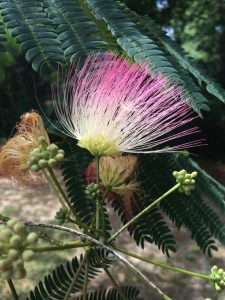
Fluffy Mimosa Bloom. Photo Credit: Mary Salinas
All along the roadsides and in home landscapes in summer, a profusion of fluffy pink blossoms are adorning trees known as mimosa, or Albizia julibrissin. This native of China was introduced to home landscapes in this country in the 1700’s to enjoy the fragrant, showy flowers and fine, lacy foliage. However, there is a dark side to this lovely tree. After blooming, it produces an abundance of pods each containing 5 to 10 seeds. Seeds can be spread by wildlife and water; this is evidenced by the appearance of mimosa trees along the roadways, streams and in our natural areas. The seeds can also remain dormant for many years, allowing the trees to keep sprouting long after the mother tree is gone.
Mimosa has been categorized as an invasive exotic plant in Florida by the University of Florida IFAS Assessment of Non-Native Plants in Florida’s Natural Areas. This designation means that the tree has not only naturalized, but is expanding on its own in Florida native plant communities. This expansion means that our native plants in natural areas get crowded out by mimosa as it reproduces so prolifically.
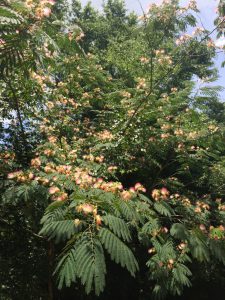
Mimosa tree in bloom. Photo Credit: Mary Salinas
The Florida Exotic Pest Plant Council (FLEPPC) publishes a list of non-native plants that have been determined to be invasive. Click here for the most recent 2017 list!
The first step in controlling this pest plant is to remove existing plants in the landscape. Cutting it down at soil level and immediately painting the stump with a 25% solution of glyphosate or triclopyr should do the trick. Further details and control methods can be found here.
There are some native trees that make excellent alternatives to mimosa such as fringe tree (Chionanthus virginicus), silverbell (Halesia carolina) and flowering dogwood (Cornus florida).
Guest Author:
Mary Salinas
Residential Horticulture Agent
Santa Rosa County
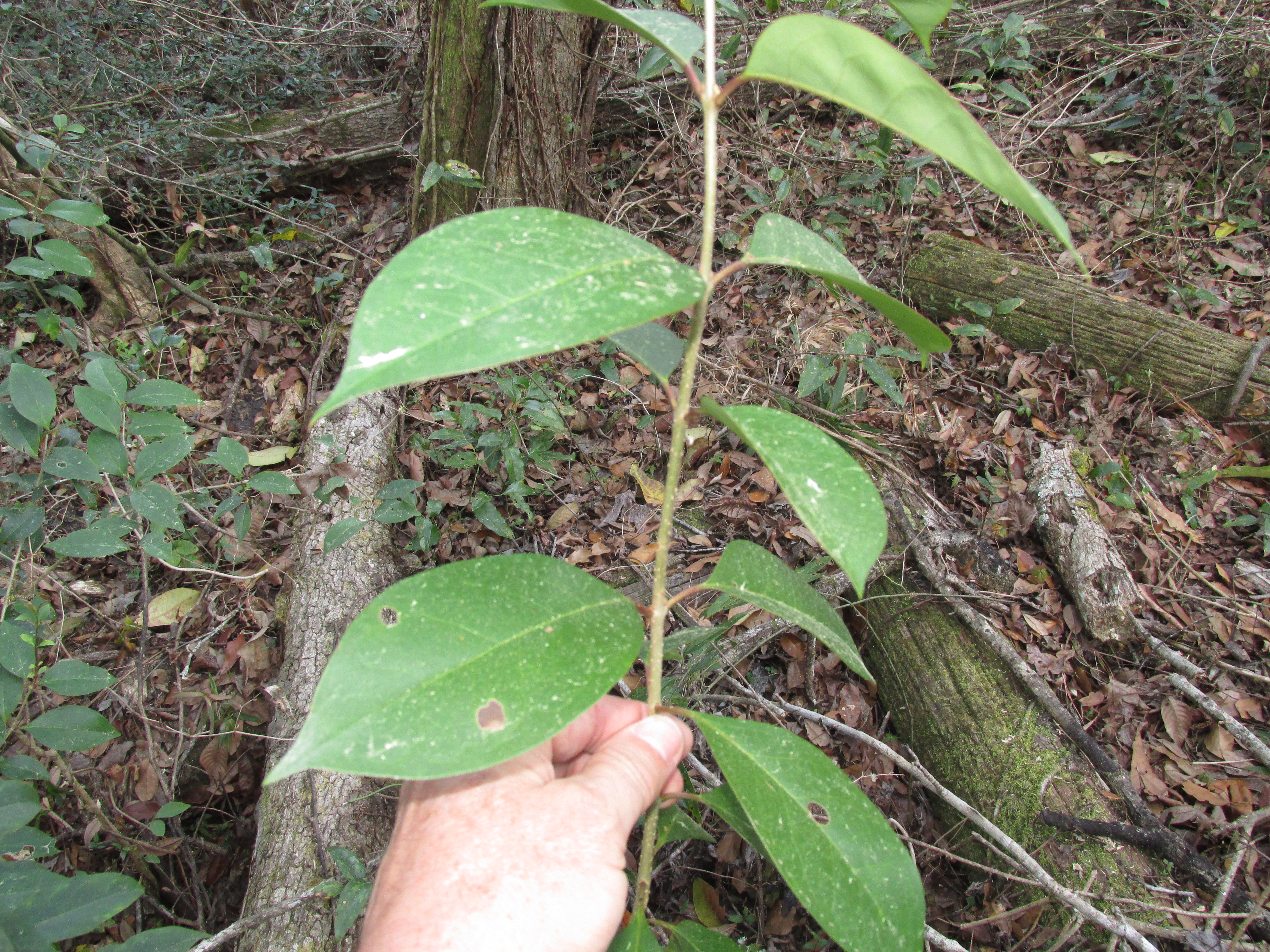
by Erik Lovestrand | Feb 26, 2018
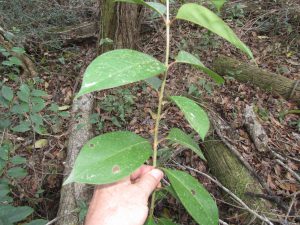
Tree privet in Wakulla County. The large shrub is rapidly becoming a dominant species in the understory of this woodlot. Photo Credit: Erik Lovestrand
Keep your eyes open for this Category 1 FLEPPC invader. When the Florida Exotic Pest Plant Council deems a plant a Category 1, it means that the plant is capable of altering native ecosystems by displacing native species. Other common names for this Ligustrum include glossy privet and wax-leaf ligustrum, which are fitting descriptions of the large, shiny leaves arranged oppositely on the stems. Belonging to the olive family (Oleaceae), this small tree can grow to 10 m tall and form a dense shady canopy above the forest understory. It has been documented in several Central to North Florida counties and has also escaped in Pennsylvania, Virginia, North Carolina, Texas, Georgia Alabama, Mississippi, Louisiana, Maryland, California and Hawaii, as well as other countries (K.A. Langeland, et al. University of Florida-IFAS Pub SP 257, 2008).
The typical growth pattern often involves multiple trunks with very smooth bark and twigs being dotted with numerous corky lenticels. Once a parent plant is established it will produce copious clusters of dark drupes that will blanket the understory with small seedlings in a short time due to very high germination rates. Birds are a likely dispersal mechanism also. It prefers a mesic hardwood hammock setting in North Florida and when cut down, readily re-sprouts with many new stems from the trunk. An herbicide application to stumps is a must for control. These plants can gain an advantage in many ways in our native habitats. They tend to be salt tolerant and are able to withstand fire well. They can grow in acidic to alkaline soils but do not do well in wet soil conditions. They will commonly colonize river banks though where the higher levees provide a deeper, sandier footing.
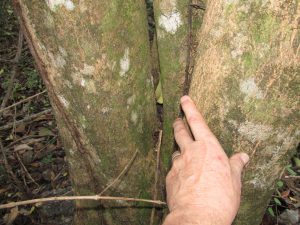
Large tree privet trunk in Wakulla County. Photo Credit: Erik Lovestrand
There are two other non-native ligustrums established in North Florida also but they are easy to separate if you look closely at the foliage. The plant commonly called Chinese ligustrum (l. sinense) has much smaller leaves. The more similar looking Japenese ligustrum (l. japonicum, also called wax-leaf privet), can be distinguished by the lack of a thin translucent margin along the leaf edges. This is easy to see if you hold a tree privet leaf against a backlit setting.
For more information on Ligustrum lucidum, visit the UF IFAS Center for Aquatic and Invasive Plants Directory
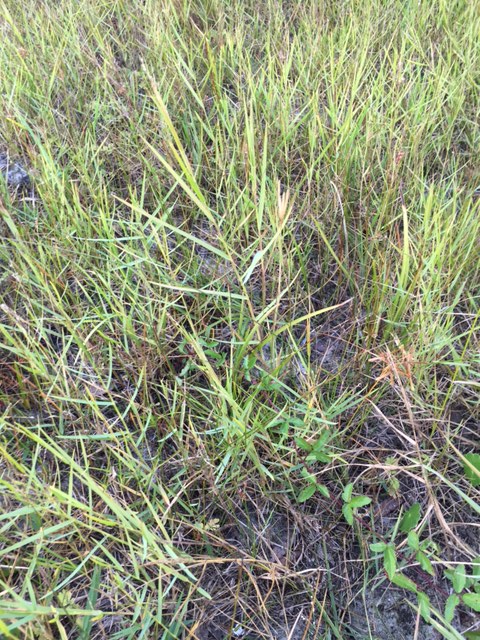
by Rick O'Connor | Feb 26, 2018

Invasive Torpedo Grass. Photo Credit: Rick O’Connor
The topic of invasive species has been with Floridians for decades. Stories of large pythons, exotic lizards, and crazy ants have been coming out of south Florida for years. Brazilian Pepper, Australian Pine, and Melaleuca are just three species of trees that have invaded the Everglades and other south Florida ecosystems.
Though we are having more problems with plants than animals, north Florida is not without their list of invasive problems. Cogongrass, Chinese Tallow, and Japanese Climbing Fern are well established and resource managers are constantly battling these and other invasives. In recent years Lionfish, Cuban Anoles, and a few sightings of Cuban Treefrogs have made their way onto our radar. All of these invasive species are causing either an environmental problem, an economic one, or both and need to be controlled. However, land and resource managers need to know what is out there to be able to do this; and the public can help.
So what can you do?
One of the most frequently used databases is www.EDDMaps.org. Land and resource managers, both public and private, can view this website to see which species are in the area, where they are located, and how common the species is. However, it is only as good as the data provided. Anyone can report an invasive species on EDDMaps.

Invasive lizard – the Cuban Anole. Photo Credit; Jerry Patee.
From the home page, you can find a variety of information on invasive species. To report a sighting you will need an account. On the toolbar at the top, you will see REPORT SIGHTINGS. Clicking here will take you through a series of questions. There is some information that you need to have ready. For example, how much area of the property does the invasive plant cover? Estimates are fine but try to be as close as possible. You will also need to know your location. Most phones have a compass on them where the Latitude and Longitude are provided. However, it will need to be converted to decimal point to be posted and there is a conversion tool on the website to do this for you. It is important to report your Longitude as a negative number, or else it will think you are in the eastern hemisphere. Photos are very MUCH desired and, again, your phone photo is good enough. On the home page, you will also see how to download the app “I’ve Got One” which is a quick and easy way to report an invasive species while in the field.
If you are not familiar with many of the invasive species, you can spend some time on the website to learn more. You can also contact your local extension office to discuss species that we know are in the area and those that are nearby. These are good species to be on the watch for and, with your help, we can help keep the website updated.
The extension offices in the Pensacola area will be hosting trainings on invasive species identification and EDDMaps reporting later this year. If interested contact Rick O’Connor (850) 475-5230.
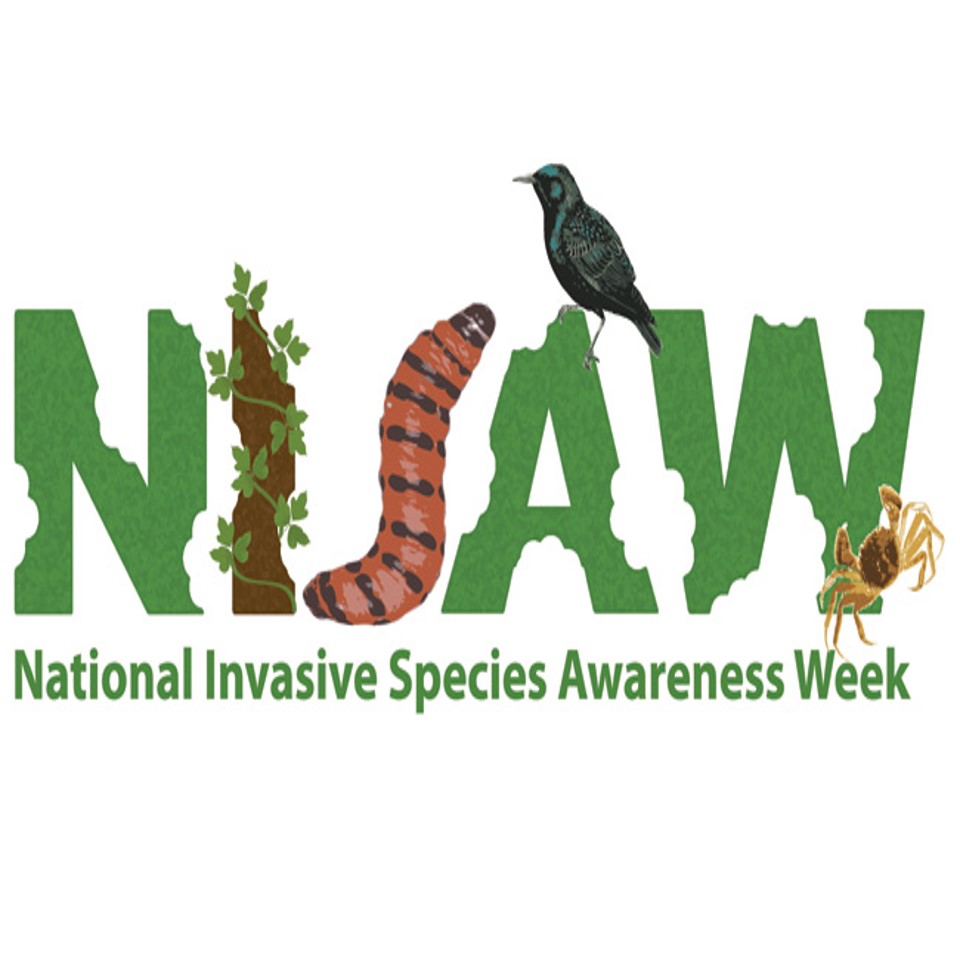
by Jennifer Bearden | Feb 2, 2018
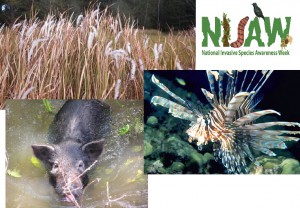 Aliens are invading our forests, pastures, fields and lawns. Well, okay, it’s not aliens but it is invasive species. Invasive species are non-native or exotic species that do not naturally occur in an area, cause economic or environmental harm, or negatively impact human health. These invasive species have become the number one threat to biodiversity on protected lands. However, invasive species do not know boundaries, and as a result, public, private lands, natural and man-made water bodies, and associated watersheds are affected. National Invasive Species Awareness Week (NISAW) is February 26-March 2, 2018.
Aliens are invading our forests, pastures, fields and lawns. Well, okay, it’s not aliens but it is invasive species. Invasive species are non-native or exotic species that do not naturally occur in an area, cause economic or environmental harm, or negatively impact human health. These invasive species have become the number one threat to biodiversity on protected lands. However, invasive species do not know boundaries, and as a result, public, private lands, natural and man-made water bodies, and associated watersheds are affected. National Invasive Species Awareness Week (NISAW) is February 26-March 2, 2018.
It is estimated that Florida Agriculture loses $179 million annually from invasive pests (http://www.defenders.org/sites/default/files/publications/florida.pdf). Generally, eradication of an invasive species is difficult and expensive. Most of the mitigation efforts focus on control rather than eradication.
EDDMaps (Early Detection and Distribution Mapping System), a web-based mapping system for reporting invasive species, currently has 667 different invasive plants reported in Florida. Many invasive insects, animals and diseases have also landed in Florida. Some famous invasive species in Florida include cogongrass, wild hogs, red imported fire ants, Chinese tallow, and lionfish.
For National Invasive Species Awareness Week, the University of Florida IFAS Northwest Extension District will highlight new invasive species each day. There are a couple of ways to receive this information during NISAW:
You can help us control invasive species in several ways:
- Always be cautious when bringing plants or plant materials into the state. Plants or even dead plant material can harbor weeds, insects and diseases that can become invasive in our state.
- When you see something suspicious, contact your local extension agent for help identifying the weed, insect or disease.
- You can volunteer your time and effort. Invasive species control is difficult and requires a cooperative effort for funding and manpower. The state has several Cooperative Invasive Species Management Areas (CISMA) in which public and private organizations work together to control invasive species in their area. These CISMAs hold work days in which volunteers can help remove invasive species from the environment. https://www.floridainvasives.org/cismas.cfm
For more information about NISAW or invasive species, contact your local county extension agent.

by Sheila Dunning | Dec 15, 2017
According to Druid lore, hanging the plant in homes would bring good luck and protection. Holly was considered sacred because it remained green and strong with brightly colored red berries no matter how harsh the winter. Most other plants would wilt and die.
 Later, Christians adopted the holly tradition from Druid practices and developed symbolism to reflect Christian beliefs. Today, the red berries are said to represent the blood that Jesus shed on the cross when he was crucified. Additionally, the pointed leaves of the holly symbolize the crown of thorns Jesus wore on his head.
Later, Christians adopted the holly tradition from Druid practices and developed symbolism to reflect Christian beliefs. Today, the red berries are said to represent the blood that Jesus shed on the cross when he was crucified. Additionally, the pointed leaves of the holly symbolize the crown of thorns Jesus wore on his head.
Several hollies are native to Florida. Many more are cultivated varieties commonly used as landscape plants. Hollies (Ilex spp.) are generally low maintenance plants that come in a diversity of sizes, forms and textures, ranging from large trees to dwarf shrubs.
The berries provide a valuable winter food source for migratory birds. However, the berries only form on female plants. Hollies are dioecious plants, meaning male and female flowers are located on separate plants. Both male and female hollies produce small white blooms in the spring. Bees are the primary pollinators, carrying pollen from the male hollies 1.5 to 2 miles, so it is not necessary to have a male plant in the same landscape.
Several male hollies are grown for their compact formal shape and interesting new foliage color. Dwarf Yaupon Hollies (Ilex vomitoria ‘Shillings’ and ‘Bordeaux’) form symmetrical spheres without extensive pruning. ‘Bordeaux’ Yaupon has maroon-colored new growth. Neither cultivar has berries.
Hollies prefer to grow in partial shade but will do well in full sun if provided adequate irrigation. Most species prefer well-drained, slightly acidic soils. However, Dahoon holly (Ilex cassine) and Gallberry (Ilex glabra) naturally occurs in wetland areas and can be planted on wetter sites.
Evergreen trees retain leaves throughout the year and provide wind protection. The choice of one type of holly or another will largely depend on prevailing environmental conditions and windbreak purposes. If, for example, winds associated with storms or natural climatic variability occur in winter, then a larger leaved plant might be required.
The natives are likely to be better adapted to local climate, soil, pest and disease conditions and over a broader range of conditions. Nevertheless, non-natives may be desirable for many attributes such as height, growth rate and texture but should not reproduce and spread beyond the area planted or they may become problematic because of invasiveness.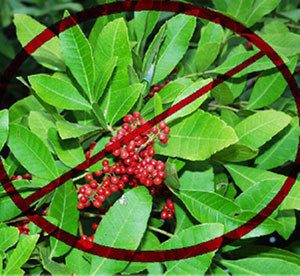
There is increasing awareness of invasiveness, i.e., the potential for an introduced species to establish itself or become “naturalized” in an ecological community and even become a dominant plant that replaces native species. Tree and shrub species can become invasive if they aggressively proliferate beyond the windbreak. At first glance, Brazilian pepper (Schinus terebinthifolius), a fast-growing, non-native shrub that has a dense crown, might be considered an appropriate red berry producing species. However, it readily spreads seed disbursed by birds and has invaded many natural ecosystems. Therefore, the Florida Department of Environmental Protection has declared it illegal to plant this tree in Florida without a special permit. Consult the Florida Exotic Pest Plant Council’s Web page (www.fleppc.org) for a list of prohibited species in Florida.
For a more comprehensive list of holly varieties and their individual growth habits refer to ENH42 Hollies at a Glance: http://edis.ifas.ufl.edu/mg021

by Rick O'Connor | Sep 15, 2017
In the late 1980’s a few exotic lionfish were found off the coast of Dania Florida. I do not think anyone foresaw the impact this was going to have. Producing tens of thousands of drifting eggs per female each week, they began to disperse following the Gulf Stream. First in northeast Florida, then the Carolina’s, Bermuda, the Caribbean, and eventually the Gulf of Mexico. The invasion was one of the more dramatic ones seen in nature.
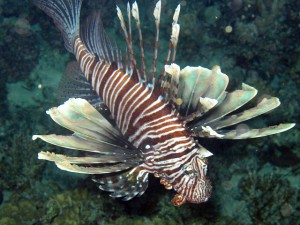
The Invasive Lionfish
Lionfish are found on a variety of structures, both natural and artificial, and are known from shallow estuaries to depths of 1000 feet in the ocean. They are opportunistic feeders, engulfing whatever is within their range and fits in their mouths, and have few predators due to their neurotoxicity spines. These fish are well-designed eating machines with a high reproductive rate, and perfectly adapted to invading new territories, if they can get there.
And they got here…
Like so many other invasive species, humans brought them to our state. Some arrive intentionally, some by accident, but we brought them. Lionfish came to Florida intentionally as an aquarium fish. Beautiful and exotic, they are popular at both public aquariums and with hobbyists… Then they escaped.
So what now?
What impact will these opportunistic fish have on the local environment? On the local economy?
This is, in essence, the definition of an invasive species. The potential for a negative impact on either the ecosystem or local fishing is there. We now know they are found on many local reefs, in many cases the dominant fish in the community. We know they can produce an average of 25,000 fertilized per female per week and breed most of the year. We also know they consume a variety of reef fish, about 70 species have been reported from their stomachs.
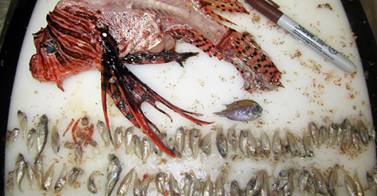
Over 70 species of small reef fish have been found in the stomachs of lionfish; including red snapper.
Photo: Bryan Clark
However, what impact is this having on local fisheries?
Well, we do know there have been more reports of fishermen catching them on hook and line. We also know that scientists are examining the DNA of their stomach content that cannot be identified visually, and some of the results indicate commercially valuable species are on the menu.
Area high school students are now conducting dissections using this same methodology. Under the direction of Dr. Jeff Eble, over 900 area high school students examined the stomach contents of local lionfish last year. Students from Escambia, Gulf Breeze, Navarre, Pensacola, Washington, and West Florida high schools – along with Woodlawn Middle School – identified 16 different species in lionfish stomachs. Of economic concern were snapper; 42% of the prey identified were Vermillion Snapper – 4% were Red Snapper.
Though the consumption of non-commercial species can affect the population of commercial ones, the direct consumption of commercial species is concerning. The commercial value of Vermillion Snapper landed in Escambia County in 2016 was about $800,000 (highest in the state).
This year two more high schools will participate in the dissection portion of this project; those being Tate and Pine Forest. These students need lionfish and we are seeking donations from local divers to help support this project. If interested in helping, please contact me at roc1@ufl.edu or (850) 475-5230.
References
Dahl, K.A. W.F. Patterson III. 2014. Habitat-Specific Density and Diet of Rapidly Expanding Invasive Red Lionfish (Pterois volitans), Populations in the Northern Gulf of Mexico. PLOS ONE. Vol 9 (8). Pp. 13.
FWC Commercial Landing Summaries. 2017. https://public.myfwc.com/FWRI/PFDM/ReportCreator.aspx.

















